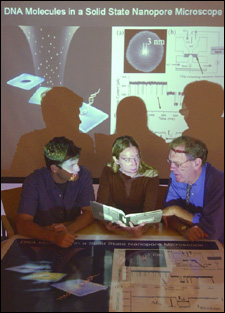Seeing the hole truth:
Small holes give a big view of genes

Holes as tiny as 30 atoms across are allowing researchers to obtain intimate views of molecules in acts never before seen. Peeping Ph.D.s have seen strands of DNA, the stuff of genes, folding themselves in a new type of microscope invented at Harvard University.
Folding is a big deal in biology. It not only changes a molecule’s shape but its function. Take the proteins made by genes. Folded one way, they can activate processes necessary for a healthy life. Folded another way, they can trigger the wild cell growth known as cancer.

“These tiny holes comprise a new kind of microscope, one that gives us a fantastic capability to look at things on an atomic scale,” says Jene Golovchenko, a Harvard professor of physics and applied physics, who leads the research. “This gives us new eyes with which to learn new things.”
An important goal of the project, Golovchenko notes, is to build devices that can do rapid gene sequencing. Instead of spending billions of dollars and years of time, he envisions inexpensive devices in a doctor’s office that read your genetic blueprints like a ticker tape. Doctors could prescribe medicines and lifestyle changes that exactly suit your individual genome, not the average genome of a human.
“That’s something that can affect everyone’s life,” Golovchenko points out.
Rapid gene fingerprinting could also aid in identifying viruses and bacteria used in bioterrorism attacks, and in learning enough about disease organisms like the West Nile and SARS viruses to speed development of vaccines.
On a more basic level, widespread, inexpensive gene sequencing could help us to better understand human evolution, including who we are and where we come from.
Getting down to atoms
The new type of microscope evolved out of a burgeoning effort in both academia and industry to make structures whose sizes are measured in nanometers instead of inches. A nanometer is a mere billionth of a meter, a millionth of a millimeter, hundreds of thousandths of an inch. “Inches” lose meaning at this scale. A 5-nanometer hole, or electronic particle, is a scant 50 atoms or so across.
Golovchenko and his colleagues use machines constructed from scratch at Harvard’s Department of Physics to delicately sculpt nanoholes using a beam of atoms as a chisel. The holes pierce sheets of silicon nitride about 100 atoms thick, or as thin as one-thousandth the thickness of a human hair. Of course, everything is done with electronics and computer-controlled research instruments.
The sheets model fragile membranes that surround human cells. The holes mimic pores, or channels, through which our cells breathe molecules in and out, molecular movements necessary to sustain life.
At first, Harvard biologists tried to do this with actual cell membranes and protein pores. But these materials do not remain stable for long. Heat breaks them down, and you can’t change their size or attach wires to make measurements of DNA and other molecules that pass through the pores. Golovchenko got around this limitation by making holes in the thinnest of solid materials. “It took us three years,” he notes, “and we learned a great deal along the way that can be applied to solving other problems in nanoscience.”
In the most recent experiments, reported in the September issue of the journal Nature Materials, Golovchenko’s team pulled strands of DNA through a nanopored sheet that separated two pools of salt water. One pool had a positive charge. The DNA and the other pool were negatively charged. “The DNA is electronically sucked through the nanopore like a piece of spaghetti,” Golovchenko explains. His research team included graduate students Derek Stein and Marc Gershow, postdoctoral fellow Jiali Li, and staff scientist Eric Brandin.
Electrodes attached to the sides of the pores measure changes in electric current caused by changes in the sequences of genes or by the folding of a molecule. These are the first experiments in which the folding of molecules has been observed in this way.
“The larger the holes, the more folds we can see,” Golovchenko notes. “It’s the new kid on the block for watching single molecules. We’re beginning to see interesting new properties and behaviors of DNA, the alphabet that spells out the meaning of life, as it passes through the microscope.”
Fast reads
In the case of fast gene sequencing, each gene is a long string of so-called bases or letters, each of which would register a different change of current as DNA moves though a pore. The arrangement of letters spells out your fortune, what color eyes you have, birth defects, and the proteins you have that make you more or less physically and mentally fit.
In the laboratory, the next giant step involves observing folding proteins. Jiali Li, who worked with Golovchenko at Harvard for three years, now is pursing this work at the University of Arkansas.
An example of what researchers would like to see is the folding of a protein called “ras.” In its activated form, ras stimulates cells to reproduce, a necessary step in wound healing and recovery from disease. But when mutations cause ras, or the proteins it interacts with, to fold in abnormal ways, cell growth may become perpetually active, resulting in cancer.
Golovchenko’s work is financed by a number of federal agencies and by Agilent Technologies in Palo Alto, Calif. That company is pursuing a commercial process to make nanopores in ultrathin solid membranes.
“Our work is stimulating others to enter this field,” Golovchenko comments. “A lot of people are very excited about the prospects.”




